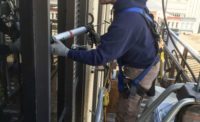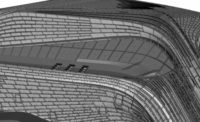A building’s envelope is described as any component of a building that touches the outside air and repels the elements such as the roof, walls, doors and windows. There are also some not-so-obvious parts of a building’s envelope that often get overlooked that include the lighting, handrails, signs, steps, pavement, concrete slabs, mechanical equipment and decorative features.
It’s important to take into consideration a building’s entire envelope, including the not-so-obvious parts, when it comes to waterproofing a building’s complete exterior.
The reason that this is so important is because a building has to have all its exterior elements 100 percent waterproof in order to keep water from entering and damaging the interior spaces.
Look at waterproofing like an offensive line of football. An offensive line has five players whose job it is to protect the quarterback, and if four of those players block really well, but the fifth one gives up a sack, it really doesn’t matter how well those four other players performed because the end result is the same. That’s kind of how waterproofing a building works. All of the elements can work really well, but if one part doesn’t do its job and lets water in, then it really doesn’t matter how well those other parts were doing at their jobs.
Coined as the 90 percent/1 percent principle by author Michael Kubal in his book The Construction Waterproofing Handbook, a small area of a building, or 1 percent, is basically going to cause the majority of a building’s problems.
If you can control and manage this one percent area, a lot of your building’s moisture issues are going to be solved, and you’re going to have a lot easier time in terms of waterproofing your building.
The one percent area of a building that causes most of the moisture problems is the gap where one component transitions into another. For example:
- Where a door meets a surrounding wall
- Where the glass of a window meets the metal frame
- Where the metal frame meets the surrounding wall
- Where a handrail meets the brick
If the sealants, glazing or caulk joints at these transition points are failing or absent, water is sure to seep in and cause damage over time. These small areas of a building’s envelope can cause the greatest damage and should be closely monitored and maintained consistently to protect the overall building.
Water is moved through a structure via any number of forces including hydrostatic pressure, capillary action, wind/air currents, surface tension and natural gravity. If there is a breach in any part of a structure's envelope, water is sure to find its way in.
Below is an outline of various types of waterproofing used for specific areas of a building or structure. Be sure to consult with an experienced specialty contractor when deciding which type of waterproofing to use.
Above-Grade Walls
The exterior walls of a building can be a significant source of unwanted water leakage. It's easy to forget how many openings are required in commercial building walls—from plumbing and irrigation connections to lighting, HVAC system elements, exhaust vents, air intakes, joints around windows and doors, and fire alarms, to name a few.
There are also unplanned holes caused by aging brick joints that need re-pointing, vanishing sealants, damage from acid rain and settling cracks. All wall penetrations provide easy access for water, bugs, field mice, birds or other unwanted pests to enter the building and cause damage.
A structure's first line of defense against the elements is above-grade waterproofing, which includes the use of caulks and sealants to seal the perimeters of windows and other openings. The amount of sealant needed on a new or existing structure depends on exposure and expansion/contraction problems that may be identified. Some types of sealants include:
- Elastomeric breathable wall coating systems
- Protective/decorative surface coatings
- Clear water repellents
Concrete, Terrace Areas and Decks
In the winter, freeze and thaw cycles can cause big problems with concrete structures. When water infiltrates concrete, it can freeze, causing the water to occupy nine percent more volume than in its liquid state. This expansion causes distress on the concrete, which can lead to fractures that will continue to grow exponentially as saturation of the material increases.
A wide range of restoration, repair and reinforcing services are offered by certified, specialty contractors who can repair cracks, spalls, rust spots, deterioration, pot-holes and heaves in concrete and masonry. More often than not, concrete repairs are made before they become a more serious or costly issue, but there are measures that you can take to actually prevent future damage. Applying hot applied or below grade waterproofing to your buried structures, a urethane waterproof traffic coating to your parking decks and protective acrylic coatings to your pedestrian areas and exterior facades will extend the life of the repair, protect adjacent areas that are currently in good condition and significantly improve the aesthetics of the area treated.
Applied over concrete, wood or steel, a variety of deck coatings are available to prevent leaks from penetrating to areas below and can maintain the surface's color and keep it looking like new for years. Recent technology has provided materials for these special coatings that are ideal for suspended slabs, recreational roof decks, garages, patios, balconies, sun decks, areas around pools and other areas that require a durable surface.
Roofs
A commitment to good roof maintenance practices can prevent overflowing gutters, clogged downspouts and excessive ponding water which can lead to costly roof, facade and foundation damage.
Decaying leaves, pine needles and dirt run-off can all contribute to ponding water and clogged gutters and downspouts, which is why it is essential that all roof drains remain clear of obstructions. In addition to the risk of water pouring into the tenant spaces should a breach in the roof occur, the freezing and thawing of ponding water during the fall and winter months can cause extensive roof damage.
Applying waterproofing to a structure's roof is important and requires a professional's expertise to determine which option will work the best. Some available roofing systems include:
- Synthetic rubber materials
- Hot rubberized asphalt
- Insulated roofing membrane systems
Below-Grade Systems
A number of excellent below-grade exterior foundation waterproofing systems have become available within the last 20 years for preventing water penetration through basement walls, concrete lids, pits and other below-ground areas. These waterproofing materials may be applied on the inside or outside of the wall or foundation.
- Fluid-applied elastomeric membranes, mastics and coatings that form a tough, seamless membrane to withstand abuse and high levels of hydrostatic pressure.
- Hot-applied rubberized asphalt for horizontal waterproofing in split-slab construction and insulated roof membrane assembly roofs.
- Single-ply sheet systems such as rubberized asphalt sheets, EPDM synthetic rubber, PVC, CPE, CSPE, Butyl rubber and Neoprene.
- Bentonite clay panel and sheet systems that swell when they become saturated to block moisture from entering a building.
Interior Systems
Metallic, capillary/crystalline and cementitious materials are currently available for waterproofing a structure's interior. These materials may be applied by brush, trowel, spray or dry-shake methods to concrete or masonry substrates opposite the source of moisture. For foundations, these materials are applied to the interior of the structure. For tanks, reservoirs and other structures that hold water, these materials are applied to the exterior.
Knowing which waterproofing coverage to specify for a particular structure is more than just a science; it is an art form. Remember to always consult with an experienced specialty contractor for the best options when waterproofing any part of a structure.






